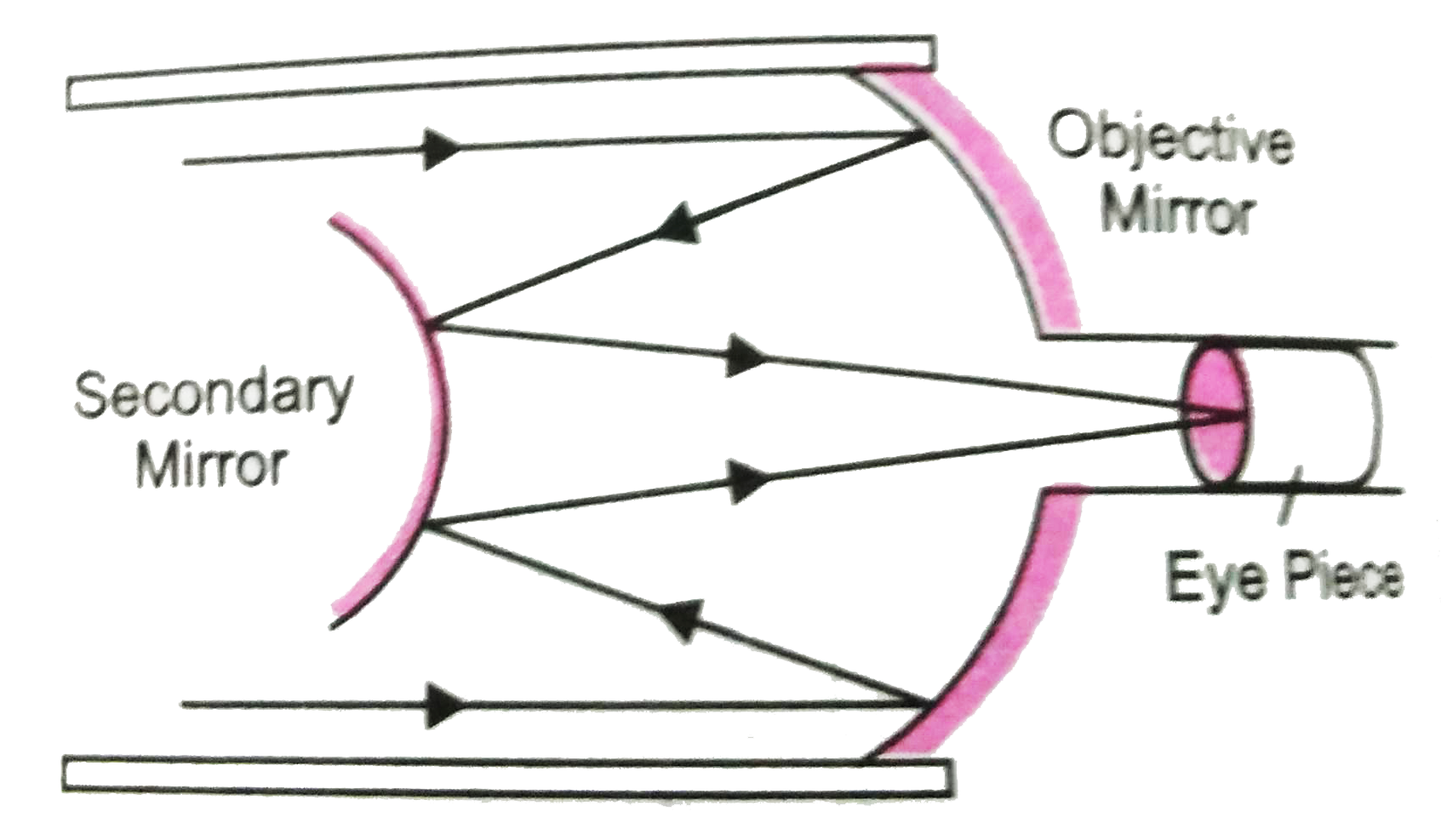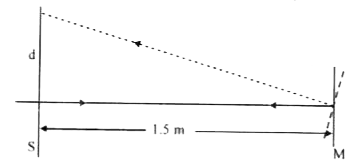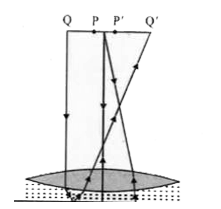Complete Solutions to EXERCISES of chapter RAY OPTICS AND OPTICAL INSTRUMENTS of Class 12 book with complete answers and questions
| Class 12 | PHYSICS |
| Chapter | RAY OPTICS AND OPTICAL INSTRUMENTS |
| NCERT TAMIL | EXERCISES |
| Number Of Questions | 40 |
| Academic Year | 2023-24 |
A small candle `2.5 cm` in size is placed `27 cm` in front of a concave mirror of radius of curvature `36 cm`. At what distance from the mirror should a screen be placed in order to receive a sharp image ? Describe the nature and size of the image. If the candle is moved closer to the mirror, how would the screen have to be moved ?
View SolutionA `4.5 cm` needle is placed 12 cm away from a convex mirror of focal length 15 cm. Give the location of the image and the magnification. Describe what happens as the needle is moved farther from the mirror.
View SolutionA tank is filled with water to a height of `12.5 cm`. The apparent depth of a needle lying at the bottom of the tank is measured by a microscope to be `9.4 cm`. What is the refractive index of water ? If water is replaced by a liquid of refractive index `1.63` upto the same height, by what distance would the microscope have to be moved to focus on the needle again ?
View SolutionFigures (a) and (b) show refraction of a ray in air incident at `60^(@)` with the normal to a glass-air and water-air interface, respectively. Predict the angle of a refraction in glass when the angle of incidence in water is `45^(@)` with the normal to a water-glass interface .

View SolutionA small bulb (assumed to be a point source) is placed at the bottom of a tank containing water to a depth of `80 cm`. Find out the area of the surface of water through which light from thr bulb can emerge. Take the value of refractive index of water to be `4//3`.
View SolutionA prism is made of glass of unknown refractive index.A parallel beam of light is incidence on the first refracting face of prism.The angle of minimum deviation is measured to be `40^(@)` .What is the refractive index of material of the prism? The refracting angle of prism is `60^(@)`. [`sin50^(@)`=0.766]]
View SolutionA double convex lens is made of glass of refractive index `1.55` with both faces of same radius of curvature. Find the radius of curvature required, if focal length is `20 cm`.
View SolutionA beam of light converges to a point P. A lens is placed in the path of the convergent beam 12 cm from P. At what point does the beam converge if the lens is (a) a convex lens of focal length 20 cm. (b) a concave lens of focal length 16 cm.
View SolutionAn object of size `3.0 cm` is placed `14 cm` in front of a concave lens of focal length `21 cm`. Describe the image produced by the lens. What happens if the object is moved further from the lens ?
View SolutionWhat is the focal length of a convex lens of focal length `30 cm` in contact with a concave lens of focal length `20 cm`. Is the system a converging or a diverging lens ? Ignore thickness of the lenses.
View SolutionA compound microscope consists of an objective lens of focal length 2.0 cm and an eyepiece of focal length 6.25 cm separated by a distance of 15 cm. How far from the objective should an object be placed in order to obtain the final image at (a) the least distance of distinct vision (25cm), and (b) at infinity? What is the magnifying power of the microscope in each case ?
View SolutionA person with a normal near point `(25 cm)` using a compound microscope with an objective of focal length `8.0 mm` and eye piece of focal length `2.5 cm` can bring an object placed `9.0 cm` from the objective in sharp focus. What is the separation between the two lenses ? Calculate the magnifying power of the microscope ?
View SolutionA small telescope has an objective lens of focal length `144 cm` and an eye-piece of focal length `6.0 cm`. What is the magnifying power of the telescope ? What is the separation between the objective and the eye-piece ?
View Solution(i) A giant refracting telescope at an observatory has an objective lens of focal length 15 m . If an eyepiece of focal length 1.0 cm is used, what is angular magnification of the telescope ?
(ii) If this telescope is used to view the moon, what is the diameter of the image of the moon formed by the objective lens ? the diameter of the moon is `3.48xx10^(6)m`, and the radius of lunar orbit is `3.8xx10^(8) m`.
View SolutionUse the mirror equation to deduct that :
(a) an object between `f` and `2f` of a concave mirror produces a real image beyond `2 f`.
(b) a convax mirror always produces a virtual image independent of the location of the object.
( c) the virtual image produced by a convex mirror is always diminished in size and is located between the focus and the pole.
(d) an object placed between the pole and focus of a concave mirror produces a virtual and enlarged image.
View SolutionA small pin fixed on a table top is viewed from above from a distance of `50 cm`. By what distance would the pin appear to be raised, if it be viewed from the same point through a `15 cm`. Thick glass slab held parallel to the table? `mu` of glass is `1.5`. Does the answer depend on location of the slab ?
View Solutiona.Figure shows a cross-section of a 'light pipe' made of glass fibre of refractive index 1.68
The outer converting of the pipe is made of a material of refractive index 1.44. What is the range of the angles of the incident rays with the axis of the pipe for which total reflections insides the pipe take place as shown in the figure.
b.What is the answer if there is no outer converting of the pipe ?

View SolutionAnswer the following questions :
Does the apparent depth of a tank of water change if viewed obliquely ? If so, does the apparent depth increase or decrease ?
View SolutionAnswer the following questions :
Does the apparent depth of a tank of water change if viewed obliquely ? If so, does the apparent depth increase or decrease ?
View SolutionAnswer the following questions :
Does the apparent depth of a tank of water change if viewed obliquely ? If so, does the apparent depth increase or decrease ?
View SolutionAnswer the following questions :
Does the apparent depth of a tank of water change if viewed obliquely ? If so, does the apparent depth increase or decrease ?
View SolutionAnswer the following questions :
Does the apparent depth of a tank of water change if viewed obliquely ? If so, does the apparent depth increase or decrease ?
View SolutionThe image of a small electric bulb fixed on the wall of a room is to be obtained on the opposite wall `3 m` away by means of a large convex lens. What is the maximum possible focal length of the lens required for the purpose ?
View SolutionA screen is placed 90 cm from an object. The image an object on the screen is formed by a convex lens two different locations separated by 20 cm. the focus length of the lense is
View Solutiona) Determine the effective focal length of the combination of the two lenses in Exercise, if they are placed 8.0cm apart with their principal axes coincident. Does the answer depend on which side of the combination a beam of paralel light is incident? Is the notions of effective focal length of this system useful at all?
b) An object 1.5 cm in size is placed on the side of the convex lens in the arrangement a) above. The distance between the object and the convex lens is 40cm. Determine the magnification produced by the two-lens system, and the size of the image.
View SolutionAt what angle should a ray of light be incident on the face of a prism of refracting angle `60^(@)` so that it just suffers total internal reflection at the other face ? The refractive index of the prism is 1.524.
View SolutionA cardsheet divided into squares each of size `1 mm^(2)` is being viewed at a distance of `9 cm` through a magnifying glass (a conerging lens of focal length `10 cm`) held close to the eye.
(a) What is the magnification produced by the lenas ? How much is the area of each square to the virtual image ?
(b) What is the angular magnification (magnifying power) of the lens ?
( c) Is the magnification in (a) equal to the magnifying power in (b) ? Explain
View Solution(i) At what distance should the lens be held from the card sheet in order to view the squares distinctly with the maximum possible magnifying power ?
(ii) What is the magnification in this case ?
(iii) Is the magnification equal to magnifying power in this case ? Explain.
View SolutionWhat should be the distance between the object and magnifying glass if the virtual image of each square in the figure is to have an area of `6.25 mm^(2)`.Would you be able to see the squares distinctly with your eyes very close to the magnifier ?
View Solutiona) The anlge subtended at the eye by an object is equal to the angle subtended at the eye by the virtual image produced by a magnifying glass. In what sense then does a magnifying glass provide angular magnifications?
b) in viewing through a magnifying glass, one usually positions one's eyes very close to the lens. Does angular magnification change if the eye is moved back?
c) magnifying power of a simple microscopes is inversely proportional to the focal length of the lens. What then stops us from using a convex lens of smaller and smaller focal length and achieving greater and greater magnifying power?
d) Why must both the objective and the eyepiece of a compound microscope have short focal lengths?
e) When viewing through a compound microscope, our eyes should be positioned not on the eyepiece but a short distance away from it fot best veiwing. Why? How much should be that short distance between the eye and eyepiece?
View Solutiona) The anlge subtended at the eye by an object is equal to the angle subtended at the eye by the virtual image produced by a magnifying glass. In what sense then does a magnifying glass provide angular magnifications?
b) in viewing through a magnifying glass, one usually positions one's eyes very close to the lens. Does angular magnification change if the eye is moved back?
c) magnifying power of a simple microscopes is inversely proportional to the focal length of the lens. What then stops us from using a convex lens of smaller and smaller focal length and achieving greater and greater magnifying power?
d) Why must both the objective and the eyepiece of a compound microscope have short focal lengths?
e) When viewing through a compound microscope, our eyes should be positioned not on the eyepiece but a short distance away from it fot best veiwing. Why? How much should be that short distance between the eye and eyepiece?
View Solutiona) The anlge subtended at the eye by an object is equal to the angle subtended at the eye by the virtual image produced by a magnifying glass. In what sense then does a magnifying glass provide angular magnifications?
b) in viewing through a magnifying glass, one usually positions one's eyes very close to the lens. Does angular magnification change if the eye is moved back?
c) magnifying power of a simple microscopes is inversely proportional to the focal length of the lens. What then stops us from using a convex lens of smaller and smaller focal length and achieving greater and greater magnifying power?
d) Why must both the objective and the eyepiece of a compound microscope have short focal lengths?
e) When viewing through a compound microscope, our eyes should be positioned not on the eyepiece but a short distance away from it fot best veiwing. Why? How much should be that short distance between the eye and eyepiece?
View Solutiona) The anlge subtended at the eye by an object is equal to the angle subtended at the eye by the virtual image produced by a magnifying glass. In what sense then does a magnifying glass provide angular magnifications?
b) in viewing through a magnifying glass, one usually positions one's eyes very close to the lens. Does angular magnification change if the eye is moved back?
c) magnifying power of a simple microscopes is inversely proportional to the focal length of the lens. What then stops us from using a convex lens of smaller and smaller focal length and achieving greater and greater magnifying power?
d) Why must both the objective and the eyepiece of a compound microscope have short focal lengths?
e) When viewing through a compound microscope, our eyes should be positioned not on the eyepiece but a short distance away from it fot best veiwing. Why? How much should be that short distance between the eye and eyepiece?
View Solutiona) The anlge subtended at the eye by an object is equal to the angle subtended at the eye by the virtual image produced by a magnifying glass. In what sense then does a magnifying glass provide angular magnifications?
b) in viewing through a magnifying glass, one usually positions one's eyes very close to the lens. Does angular magnification change if the eye is moved back?
c) magnifying power of a simple microscopes is inversely proportional to the focal length of the lens. What then stops us from using a convex lens of smaller and smaller focal length and achieving greater and greater magnifying power?
d) Why must both the objective and the eyepiece of a compound microscope have short focal lengths?
e) When viewing through a compound microscope, our eyes should be positioned not on the eyepiece but a short distance away from it fot best veiwing. Why? How much should be that short distance between the eye and eyepiece?
View SolutionAn angular magnification (magnifying power) of `30 X` is desired using an objective of focal length `1.25 cm` and an eye piece of focal length `5 cm`. How will you set up the compound microscope ?
View SolutionA small telescope has an objective lens of focal length 140 cm and an eyepiece of focal length 5.0 cm. what is the magnifying power of the telescope for viewing distant objects when
(a) the telescope is in normal adjustment (i.e, when the final image is at infinity ),
(b) The final image is formed at the least distance of distinct vision (25 cm )
View Solution(a) For the telescope described what is the separation between the objective lens and eye piece ?
(b) If this telescope is used to view a `100 m` tall tower `3 km` away, what is the height of the image of the tower formed by the objective lens ?
(c ) What is the height of the final image of the tower if it is formed at 25 cm` ?
View SolutionA Cassegrainian telescope uses two mirrors as shown in Fig. Such a telescope is built with the mirrors `20 mm` apart. If the radius of curvature of large mirror is `220 mm` and the small mirror is `40 mm`, where will the final image of an object at infinity be ?

View SolutionLight incident normally on a plane mirror attached to a galanometer coil retraces backwards as shown in figure . A current in the coil produces a deflection of `3.5^(@)` of the mirror. What is te displacement of the reflected spot of light on a screen placed 1.5 m away ?

View SolutionFigure shows an equiconvex lens (of refractive index 1.50 ) in contact with a liquid layer on top of a plane mirror. A small needle with its tip on the principal axis is moved along the axis until its inverted image is found at the position of the needle. The distance of the needle from the lens is measured to be 45.0 cm. The liquid is removed and the experiment is repeated . the new distance is measured to be 30.0 cm. What is the refractive index of the liquid ?

View Solution
EXERCISES questions and complete solutions for chapter RAY OPTICS AND OPTICAL INSTRUMENTS of FULL MARKS PHYSICS(TAMIL) of Class 12